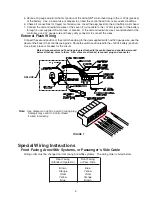
2
Introduction
The ArrowStik
®
is a traffic directing device that will mount in many locations including the back of a lightbar or
rear panel of a truck. The ArrowStik is a series of lights that point traffic away from the scene of an accident or
work site.
The ArrowStik uses standard 1156 incandescent lamps for operation. The lamp and reflector assembly are
mounted into the sliding track of the painted aluminum extrusion for easy maintanence.
The ArrowStik control box delivers four (4) distinct warning patterns: arrow left, arrow right, center out, and
alternating flash. An Arrowstik controller with fast speed, night light dimming, and an auxiliary 12 amp switched
output is also available.
The ArrowStik
draws a maximum of twenty (20) amps during its cycle, while averaging less than ten (10) amps.
Unpacking & Pre-installation
After unpacking the items, carefully inspect the unit and its associated parts for any damage that may have
been caused in transit. Report any damage to the carrier immediately.
Installation & Mounting
The ArrowStik was designed with a flexible mounting system to allow its use with as many lightbars as possible.
The following installation instructions provide direction for mounting the ArrowStik to the
Code 3
®
XL 5000
TM
Series and LP 6000
TM
Series Lightbar frames. Information is given, however, that mounting on other lightbar
systems should be possible. Questions about a specific application should be directed to the Technical Hotline
number given on the last page of this manual.
Permanent Mounting
Prior to mounting, consideration must be given to cable location and lamp replacement. The cable should
exit the endcap on the driver's side unless otherwise specified. Lamp replacement requires 48" of clearance
on the cable side to remove the light head assembly.
The use of this or any warning device does not insure that all drivers can or will observe or react
to an emergency warning signal. Never take the right-of-way for granted. It is your
responsibility to be sure you can proceed safely before entering an intersection, driving against
traffic, responding at a high rate of speed, or walking on or around traffic lanes.
The effectiveness of this warning device is highly dependent upon correct mounting and wiring.
Read and follow the manufacturer’s instructions before installing or using this device. The
vehicle operator should insure daily that all features of the device operate correctly. In use,
the vehicle operator should insure the projection of the warning signal is not blocked by vehicle
components (i.e.: open trunks or compartment doors), people, vehicles, or other obstructions.
This equipment is intended for use by authorized personnel only. It is the user’s responsibility
to understand and obey all laws regarding emergency warning devices. The user should
check all applicable city, state and federal laws and regulations.
Public Safety Equipment, Inc., assumes no liability for any loss resulting from the use of this
warning device.
Proper installation is vital to the performance of this warning device and the safe operation of
the emergency vehicle. It is important to recognize that the operator of the emergency vehicle
is under psychological and physiological stress caused by the emergency situation. The
warning device should be installed in such a manner as to: A) Not reduce the output
performance of the system, B) Place the controls within convenient reach of the operator so
that he can operate the system without losing eye contact with the roadway.
Emergency warning devices often require high electrical voltages and/or currents. Properly
protect and use caution around live electrical connections. Grounding or shorting of electrical
connections can cause high current arcing, which can cause personal injury and/or severe
vehicle damage, including fire.
PROPER INSTALLATION COMBINED WITH OPERATOR TRAINING IN THE PROPER USE
OF EMERGENCY WARNING DEVICES IS ESSENTIAL TO INSURE THE SAFETY OF
EMERGENCY PERSONNEL AND THE PUBLIC.
!
WARNING!
Summary of Contents for ARROWSTIK AS-10
Page 10: ...FIGURE 10 7 6 1 9 2 3 4 11 12 13 10 14 16 5 15 8 10...
Page 11: ...Notes 11...






























